In this article, I talk about:
- Reverb Basics: What is Reverb?
- 4 important Reverb Parameters you can tweak
- 6 tips to help you apply Reverb to Vocals
- I also tested 3 Reverb Plugins including: Eaverb, Sparkverb, and Toraverb. I link to the demos at the bottom of the article. (so you can test them if you want.)
*ALSO, This week I started a 30 day Ableton Live free trial (i’m a Pro Tools user). So far, I love Ableton. If you use virtual instruments, you need to check it out. I’ll give a full review of Ableton in a couple weeks.
Reverb Basics: What is Reverb?
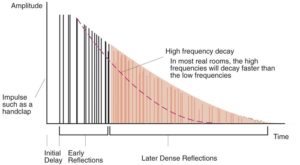 Reverb is the sound reflection that a listener hears when it bounces off of a surface in a room, or surface of an object.
Reverb is the sound reflection that a listener hears when it bounces off of a surface in a room, or surface of an object.
The density and type of material that make up a surface, as well as the number of surfaces, determines how a sound reflects around a room, and what the reverb will sound like.
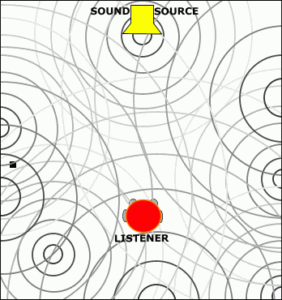 For example: a square room with 6 surfaces will have less reflective surfaces than a church. There will be less reflections as a result.
For example: a square room with 6 surfaces will have less reflective surfaces than a church. There will be less reflections as a result.
The density of the surface also determines the type of frequencies that will be reflected back to the listener. Certain materials might absorb or reflect high or low frequencies.
For example, a church with marble floors or walls will also bounce back a different spectrum of frequencies, than a carpeted room.
4 Reverb Parameters to Tweak
Here are 4 parameters of a reverb that you can tweak to get the sound you want. They are 1) early reflections, 2) decay time, 3) damping, and 4) pre-delay.
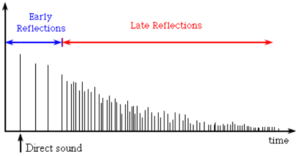
- Early reflections are the initial echoes that are heard when the first reflections hit the listeners ear.
These early reflections usually occur within 5 – 20 milliseconds after the initial sound.
- Louder early reflection settings tend to be used on longer sustained sounds like vocals, instead of drums.
2. The decay time is the length it takes for the last perceptible echo to
be heard by the listener.
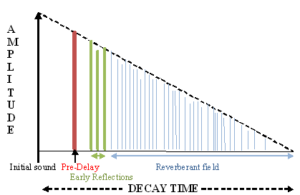 The longer the decay time, the longer it will take your reverb reflections to die out.
The longer the decay time, the longer it will take your reverb reflections to die out.
Longer decay times might work better when instrumentation is minimal, but they can make a mix sound washed out in a complex arrangement with many instruments.
3. Pre-Delay is the time it takes for a sound to generate its first reflection.
- Try increasing the pre-delay time to add separation and clarity to vocals and instruments.
4. Damping occurs when a reflection hits a soft surface, such as a carpet, and it loses some of the high frequencies in its reflection.
- If your reverb sound contains too many high frequencies, try increasing the level of damping.
6 Main Types of Reverbs
Reverbs used in music production usually fall within the 6 categories below:
Plate: A plate reverb is a method of generating reverb in 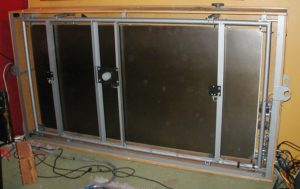 which a sound was played into a metal plate, held in place by springs. Digital plate reverbs mimic this technique.
which a sound was played into a metal plate, held in place by springs. Digital plate reverbs mimic this technique.
Plate reverbs are commonly used in production on vocals, organs, and snare drums to give them length, width, and a bright sound.
Hall: A hall reverb mimics the reflections that occur in a concert hall. This type of reverb generally lasts between 1.2 to 3 seconds.
Halls reflect from the low end of the frequency range.
Hall reverbs can add 3 dimensional ambience and width to a mix. Halls tend to have strong first reflections and can be used on lead vocals, strings, or a stereo mix.
Chamber: a chamber is a smaller space than a hall an creates reverbs ranging from .4 to 1.2 seconds. Chambers can be used on pads, vocals, or drums.
Room: A room reverb mimics the acoustic reflections of a small room.
Room reverbs have a ‘short decay time’, that can last between .2 to 1 second. The reflections of a room reverb are initially strong, but fade quickly. Room reverbs can be used on stereo mixes, drums, or guitar.
- Room reverbs can also be used as a slap delay alternative, by lengthening the pre-delay and shortening the reverb time.
Spring: a spring reverb simulates the reverb generation method in which a 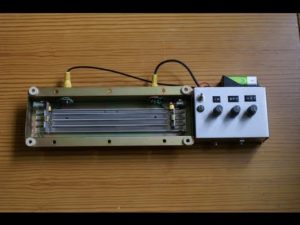 sound was played through a metal spring by a transducer; a spring reverb is most commonly used in guitar amplifiers.
sound was played through a metal spring by a transducer; a spring reverb is most commonly used in guitar amplifiers.
This type of reverb gives a vintage sound and is most commonly used on instruments like organ or guitar.
Reverse Reverbs: with this type of reverb the sound of the reflections runs in reverse, gradually getting louder instead of quieter.
6 Reverb Tips for Vocals
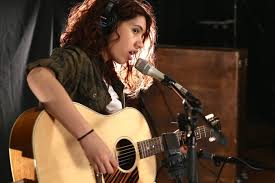 Here are a few tips you might test out when tweaking a reverb on your vocals:
Here are a few tips you might test out when tweaking a reverb on your vocals:
- Use longer pre-delays to add clarity by separating the vocals from your initial reverb reflection.
- Try EQing the send to remove unwanted high and low frequencies, that can make you mix muddy.
- Compress the reverb after it hits the plugin to smooth it out.
- Try pumping a dry vocal into a natural space and record the natural reverb and ambience of a real room.
- Add in your reverbs while playing the full mix, instead of while you are soloing the instrument or vocals.
- If you have a complex arrangement, reverbs that are too long will make your mix sound washed out.
Reviews of The 3 Reverb Plugins I Demoed
SO, I tested demos of 3 well rated reverb plugins in Ableton that are available in both VST/AU format. They include: Toraverb, Eaverb, and Sparkverb.
The plugins cost in the range of $40 – $150. All of the plugins have demos 10 – 14 day demos, so you can test them yourself.
Toraverb Review
 Toraverb is a great, low priced plugin at $45. It is well rated, and it was my favorite, even when compared to the $130 – $150 reverb plugins.
Toraverb is a great, low priced plugin at $45. It is well rated, and it was my favorite, even when compared to the $130 – $150 reverb plugins.
Here are the Features i liked:
- simple interface – i preferred the simple knob interface over the graphical interface of the more expensive plugins. Some of the features of the other plugins i felt were a bit overkill.
- sounds great – i preferred the presets and overall sound of Toraverb over the more expensive reverbs. It just sounded better to me, when compared to the others.
- low cost – it costs $45, compared to $130 – $150.
Features i disliked:
- none. It sounded great, its pretty cheap, and i preferred the simple, classic interface.
Advertised Features of Toraverb
Toraverb features include: high quality diffusing algorithms that eliminate flutter echo effects, equalization of early and late reflections, modulated tail, and spacial reflections.
It was rated 5 stars, out of 116 ratings.
It comes in both VST and AU format. The cost of Toraverb is $45.
You can download a two week free trial (with some limitations) of Toraverb here.
EAreverb Review
Eaverb is well rated, has MANY features to tweak, but it more expensive reverb plugin at $136.
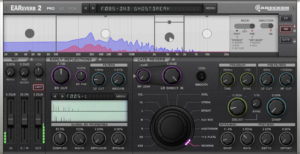 Eaverb has a nice graphical interface, and has MANY parameters you can tweak. (Almost TOO many.)
Eaverb has a nice graphical interface, and has MANY parameters you can tweak. (Almost TOO many.)
Here are the Features i liked:
- many, many tweakable parameters
- graphical interface
- you can alter the left and right reflections individually
- POS mode – you can position a sound in anywhere in a room
- i preferred working in SE mode (which is a simpler interface)
Here are the Features i disliked:
- i felt it was overkill.
- it didnt sound as good as the cheaper $45 Toraverb
- the cost is a bit high at $136
Advertised Features of Eaverb
It has six different reverb algorithms including: natural, bright, Alu box, Auditorium, Plate, and Reverse.
 It includes three modes including: Pro mode that gives access to all features and parameters.
It includes three modes including: Pro mode that gives access to all features and parameters.
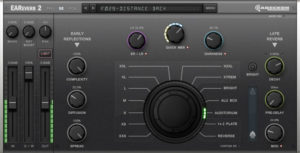 SE mode provides a simpler, limited, interface to create your reverb sound.
SE mode provides a simpler, limited, interface to create your reverb sound.
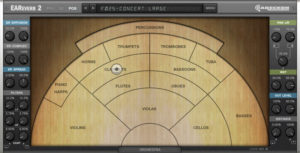 POS mode allows you to place an instrument in a particular location in a room.
POS mode allows you to place an instrument in a particular location in a room.
Eareverb comes in AU, AAX, VST format. The cost of Eareveb is $136
You can download a free trial of 10 day trial of Eareverb here.
Sparkverb Review
Sparkverb is a high quality reverb, which has a unique interface and make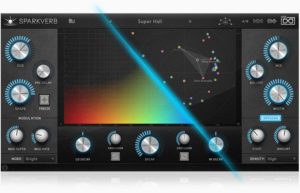 dialing in the right sound a quick, and simple process.
dialing in the right sound a quick, and simple process.
It has a feature called Preset Voyager, which allows you to surf though presets based on their characteristics.
Here are the Features of Sparkverb i liked:
- the interface is pretty cool, it makes altering the sound very easy.
- Preset Voyager mode is cool. It lets you surf through presets based on a graphical representation of their characteristics, instead of one by one.
- tweak parameters easily
- sounds pretty good
Here are the Features i disliked:
- the cost is a bit high at $150
- didn’t sound quite as good to me as the low priced Toraverb
Advertised Features of Sparkverb
It allows you to adjust decay globally, across multiple frequency bands w/ hi-lo multipliers and crossovers directly with a single interface.
The supported formats are AU, AAX, and VST.
The cost of Sparkverb is $149.
You can download a 15 day free trial of Sparkverb here.